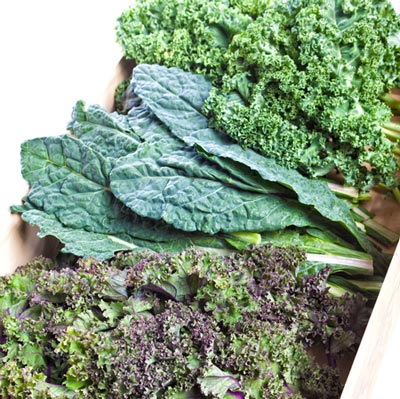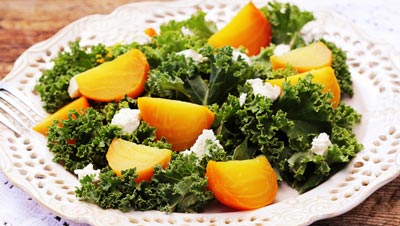Cancer-Fighting Health Benefits of Kale
- Evidence of Kale's Anticancer Effects
- Other Potential Health Benefits of Kale
- Best Ways to Prepare and Use Kale

Did You Know?
Chinese kale, belonging to the alboglabra variety of kale, is thought to be the ancestor of all B. oleracea vegetables.(ii.73)
Leafy kale doesn't look very much like broccoli or cabbage. However, it's actually part of the same cancer-fighting cruciferous vegetable family (Brassica oleracea). The variety of kale most commonly grown in the USA (and Korea) is Brassica oleracea acephala.(ii.71-74)
Lab, animal, and clinical studies suggest that whole kale, kale sprouts, or kale juice:
- Can reduce formation of carcinogens from nitrates in the diet.(ii.75)
- Block free radical damage to DNA linked to colon cancer.(ii.76)
- Kills colon cancer, prostate cancer, and stomach cancer cells.(ii.77-79)
Population studies also show a link between diets high in cruciferous vegetables and lower risk of developing lung cancer, colorectal cancers, and prostate cancer.(ii.80, 81)
Anticancer Compounds in Kale
Perhaps the best studied group of cancer-fighting compounds specifically found in kale (and other cruciferous vegetables) is the glucosinolates. These which are the precursor compounds to anticancer isothiocyanate compounds:(ii.72, 74, 82, 83)
- Sinigrin (precursor to allyl isothiocyanate)
- Gluconapin (precursor to 3-butenyl isothiocyanate found in seeds)
- Glucoerucin
- Glucobrassicin (precursor to indole-3-carbinol and ascorbigen)
Kale seeds also contain glucoraphanin, the precursor of the well-known cancer fighting compound sulforaphane found in high amounts in broccoli. In fact, 6 cultivars of kale have comparable amounts or even higher amounts of sulforaphane than broccoli - especially black kale.(ii.84)
The amount of glucosinolates in kale depends on the sulfur content of the soil it is grown in. Cooking and processing also affects the amount of glucosinolates in kale.(ii.72, 85)
Antioxidant, Anti-Inflammatory, and Immune-Boosting Effects
Besides antioxidant and anti-inflammatory protection against cancer, studies show kale and kale compounds also have the following anticancer properties that:(ii.83, 86, 87)
- Boost the immune system's ability to fight cancer cells.
- Detoxify substances that are known to cause cancer (carcinogens).
- Induce cancer cell arrest and/or death, including activating enzymes involved in cancer cell death.
- Improve the effectiveness of chemotherapy and/or radiation.
- Inhibit growth factors and other enzymes/proteins (and their receptors) that promote cancer growth and metastasis.
Evidence of Potential Anticancer Effects
Clinical, lab, and animal research suggests these properties in kale compounds may help prevent and treat many different types of cancer.(ii.75-77, 82, 84, 86)
Did You Know?
Kale is a biennial plant that grows in the spring/summer and autumn/winter. Its cancer-fighting benefits appear to be more effective if grown organically. Kale crops picked later in the year contain more carotenoids than those picked earlier in the year. Perhaps this is why fall kale has sweeter and better-tasting leaves!(ii.74, 77, 78)
When looking to buy kale, you may want to choose red curly kale if you're going to cook it. Why? Even though red kale has less glucosinolates and phenolic compounds than green kale, it does have more vitamin C. And studies show the beneficial compounds in red kale withstand the heat of cooking better than green kale.(ii.77)
Although most compounds prevalent in kale have anticancer effects, one compound has been shown to cause DNA damage in colon cells. The concentration of this aldehyde compound found to be toxic in an animal study was equivalent to the amounts found in food.(ii.82, 196)
Other Health Benefits of Kale
Kale offers a significant amount of minerals in each low-calorie serving, including calcium. Kale also contains high-grade protein, dietary fiber, chlorophyll, and prebiotic carbohydrates.(ii.71-74, 179)
Lab and animal preclinical studies, as well as a few human clinical trials, suggest that kale and kale juice could help prevent or treat the following health conditions:
- Age-related macular degeneration (AMD)(ii.197, 198)
- Alzheimer's disease(ii.199, 200)
- Bacterial infections(ii.110)
- Diabetes(ii.201)
- Elevated cholesterol levels(ii.202)
- Heart disease (in people with metabolic syndrome)(ii.203)
- High blood pressure(ii.204)
Kale extract also significantly improves levels of collagen and elastin in the skin. This means that kale could effectively block premature skin aging.(ii.205)

Best Ways to Prepare, Use, or Store Kale
Fresh kale leaves are high in cancer-fighting glucosinolates, containing about 85 mg per 100 grams of uncooked weight. Cooking and processing kale reduces the amount of these beneficial compounds, but at different rates. So what's the best way to preserve the kale's cancer-fighting effects?(ii.77, 85, 206)
Research suggests that boiling kale is the worst way to cook it, since glucosinolates leach into the water. Boiling also reduces beneficial antioxidants in kale. Instead, try steaming, stir-frying, or microwaving, which only cause minimal losses of these anticancer compounds. Steaming may be the best option of all cooking methods for kale since it doesn't leach out glucosinolates or degrade antioxidants.(ii.113, 179, 207)
If you want to store kale, blanch and freeze kale leaves. Freezing cooked kale is next best, followed by canned kale. Dried kale has the least amount of glucosinolates remaining after a year.(ii.85)


